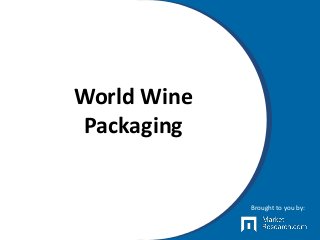
World Wine Packaging
- 1. World Wine Packaging Brought to you by:
- 2. Glass bottles, mainly in the familiar 750-milliliter size, remain the dominant packaging format for wine. However, the near-monopolistic grip that glass bottles once had has been loosened by bag-in-box containers, aseptic cartons, and several other package types. While these formats are generally not ideal for wine that will be aged for an extended period, they are suitable for wines intended for consumption not long after they are bottled -- and such wines account for most of the world’s wine. Trade has been an important component of the global wine industry for centuries, and several of the world’s largest wine producing countries have long produced far more wine than their domestic markets can consume, while a number of significant wine consuming nations rely on imports. In recent years, a growing share of the global wine trade is shipped in bulk. Advances in bulk packaging technology have enabled shipping of vast quantities of wine. This saves a considerable amount in shipping costs, particularly for wine that will eventually appear in stores in heavy, breakable glass bottles. Study coverage: World Wine Packaging analyzes the world wine packaging market. It presents historical data (2005, 2010, 2015) plus forecasts (2020, 2025) for supply and demand by wine packaging type (containers, closures, labels, capsules, wire hoods, bulk packaging) and wine container type (glass bottles, bag-in box, aseptic cartons, plastic bottles, other) in five regions and 25 countries. The study also considers market environment factors, assesses industry structure, analyzes company market share and profiles industry participants worldwide. World Wine Packaging
- 3. Sample Table TABLE IV-1 World Wine Packaging Demand by Region (million dollars) Item 2005 2010 2015 2020 2025 World Wine Production (mil liters) $ packaging/liter World Wine Packaging Demand North America Europe Asia/Pacific Latin America* Africa/Mideast *includes Mexico
- 4. View Complete Description and TOC Now Demand by Region Product Overview Containers Glass Bottles Bag-in-Box Aseptic Cartons Other Containers Plastic Bottles Pouches Aluminum Cans All Other Cork Metal Screw Caps Synthetic Stoppers Plastic Closures Other Closures Other Packaging Products Labels Capsules Bulk Packaging Wire Hoods Sustainability & Recyclability For more information about World Wine Packaging Including:
- 5. We Help You Find the Business Intelligence You Need Knowledge Center With our Knowledge Center solution, you gain unlimited, company-wide access to an entire catalog of industry- specific market research reports for one fixed cost, providing your organization with both predictability of spend and reliability of coverage. Plus, you will reduce time and stress by utilizing the Knowledge Center’s powerful and convenient platform functionality, including advanced full-text search, instant downloads, and alert and usage-tracking tools. Profound MarketResearch.com’s Profound solution allows you to maximize your research budget by purchasing only the specific data you need. Extract individual sections, tables, charts or graphs from our comprehensive collection of more than 800,000 market research reports from more than 200 publishers across nearly 700 industry sectors. Market Research Reports MarketResearch.com provides you with instant online access to the most comprehensive collection of market intelligence products and services available on the Web. Our extensive database offers reports from more than 720 leading publishers, offering expert insights on global industries, products, company profiles, and market trends.
- 6. For more information and additional research, visit MarketResearch.com or call 800.298.5699 Brought to you by:
